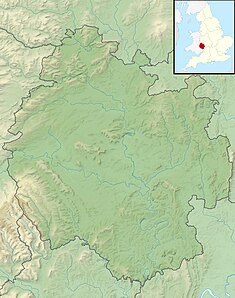
Ramsey Abbey was a Benedictine abbey in Ramsey, Huntingdonshire, England. It was founded about AD 969 and dissolved on 22 November 1539.

Adforton is a small village and a civil parish in north Herefordshire, England. It is on the A4110 main road approximately 22 miles (35 km) north of Hereford and of Wigmore, and is close to the Wales border.

John Spurley Challis was an English actor. He had an extensive television career but is best known for portraying Terrance Aubrey "Boycie" Boyce in the long-running BBC Television sitcom Only Fools and Horses (1981–2003) and its sequel/spin-off The Green Green Grass (2005–2009), as well as Monty Staines from the seventh series onwards in the ITV sitcom Benidorm, from 2015 to 2018.
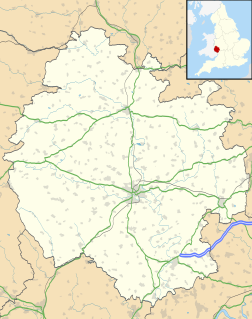
Wigmore is a village and civil parish in the northwest part of the county of Herefordshire, England. It is located on the A4110 road, about 8 miles (13 km) west of the town of Ludlow, in the Welsh Marches. In earlier times, it was also an administrative district, called a hundred.
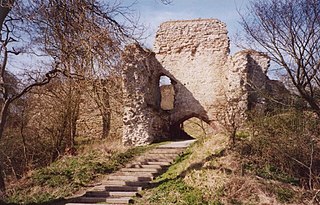
Wigmore Castle is a ruined castle about 1 km (0.62 mi) from the village of Wigmore in the northwest region of Herefordshire, England.
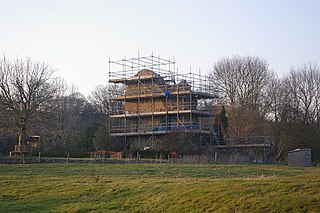
Wigmore Abbey was an Augustinian abbey with a grange, from 1179 to 1530, situated about a mile (2 km) north of the village of Wigmore, Herefordshire, England: grid reference SO 410713. Only ruins of the abbey now remain and on Historic England's Heritage at Risk Register their condition is listed as 'very bad'.

Cerne Abbey was a Benedictine monastery founded in 987 in the town now called Cerne Abbas, Dorset, by Æthelmær the Stout.

Whalley Abbey is a former Cistercian abbey in Whalley, Lancashire, England. After the dissolution of the monasteries, the abbey was largely demolished and a country house was built on the site. In the 20th century the house was modified and it is now the Retreat and Conference House of the Diocese of Blackburn. The ruins of the abbey are recorded in the National Heritage List for England as a designated Grade I listed building, and are a Scheduled Ancient Monument.
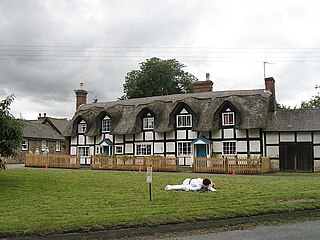
Brampton Bryan is a small village and civil parish situated in north Herefordshire, England close to the Shropshire and Welsh borders.

The village of Kinsham lies in the wooded hills of Herefordshire, England in the Marches near to the border with Wales and near the town of Presteigne. Surrounding villages include Stapleton and Lingen. Kinsham lies on the River Lugg. The 2001 census records that 71 people lived in the parish of Kinsham, of whom 32 were male and 39 female.
Mendip is a local government district in the English county of Somerset. The Mendip district covers a largely rural area of 285 square miles (738 km2) ranging from the Mendip Hills through on to the Somerset Levels. It has a population of approximately 11,000. The administrative centre of the district is Shepton Mallet.

Saighton Grange originated as a monastic grange. It was later converted into a country house and, as of 2013, the building is used as a school. It is located in Saighton, Cheshire, England. The only surviving part of the monastic grange is the gatehouse, which is recorded in the National Heritage List for England as a designated Grade I listed building, and is one of only two surviving monastic manorial buildings in Cheshire, the other being Ince Manor. The rest of the building is listed at Grade II, as is its chapel.

St Osyth's Abbey was a house of Augustinian canons in the parish of St Osyth in Essex, England in use from the 12th to 16th centuries. Founded by Richard de Belmeis, Bishop of London, c. 1121, it became one of the largest religious houses in Essex. It was dedicated to Saints Peter and Paul as well as St Osyth (Osith), a royal saint and virgin martyr. Bishop Richard obtained the arm bone of St Osyth from Aylesbury for the monastic church and granted the canons the parish church of St Osyth.

Pencombe with Grendon Warren is a civil parish in the county of Herefordshire, England. The parish was created in 1895 from the parishes of Pencombe and Grendon Warren, its only nucleated settlement being the village of Pencombe.

Harewood is a civil parish in Herefordshire, England. It is approximately 7 miles (11 km) south from the city and county town of Hereford and 4 miles (6 km) north-west from the market town of Ross-on-Wye. Within Harewood is the rural estate of Harewood Park, owned by the Duchy of Cornwall. The parish is part of the Wye Valley Area of Outstanding Natural Beauty.

Croft and Yarpole is a civil parish in the county of Herefordshire, England, and is 17 miles (27 km) north from the city and county town of Hereford. The closest large town is the market town of Leominster, 4.5 miles (7 km) to the south. Within the parish is the National Trust property of Croft Castle and Parkland.

Eye, Moreton and Ashton is a civil parish in the county of Herefordshire, England. The parish is 15 miles (24 km) north from the city and county town of Hereford. The closest large town is the market town of Leominster, 3 miles (5 km) to the south. Within the parish is the National Trust property of Berrington Hall.

King's Pyon is a village and civil parish in the county of Herefordshire, England, and is approximately 8 miles (13 km) north-west from the city and county town of Hereford. The closest large town is the market town of Leominster, 6 miles (10 km) to the north-west. The parish includes the Grade I listed church of St Mary the Virgin.

Place Farm is a complex of medieval buildings in the village of Tisbury, Wiltshire, England. They originally formed a grange of Shaftesbury Abbey. The farmhouse, the inner and outer gatehouses and the barn, reputedly the largest in England, are all Grade I listed buildings.
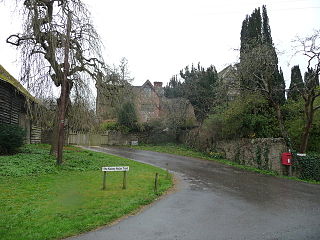
Rodd, Nash and Little Brampton is a civil parish in the county of Herefordshire, England, and is 18 miles (29 km) north-west from the city and county town of Hereford. The parish borders Powys in Wales at its north-west. Within the parish is the final home and studio of the 20th-century Australian artist Sydney Nolan.

